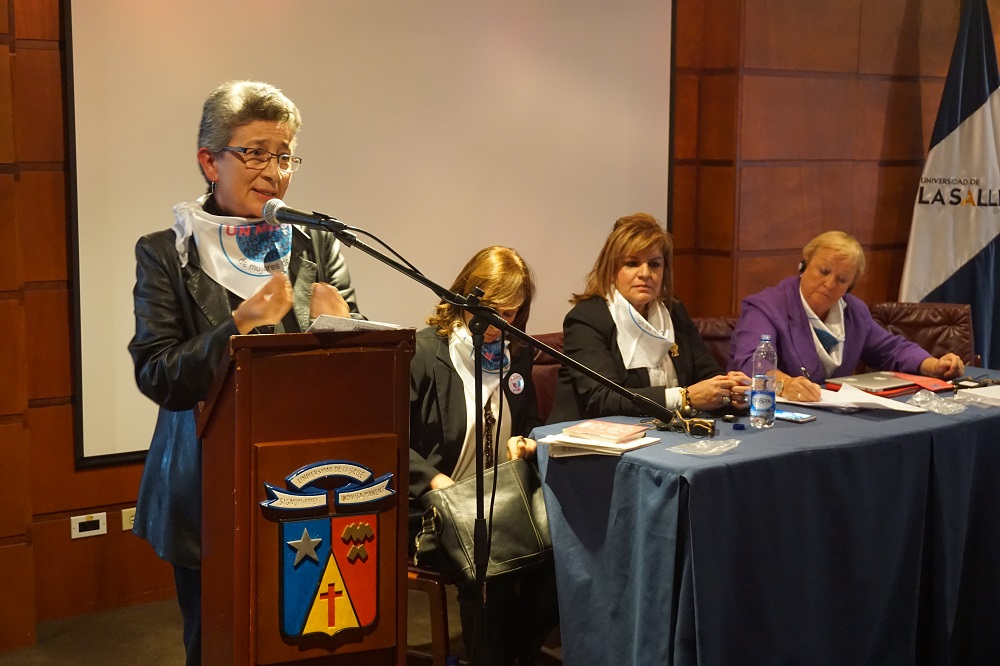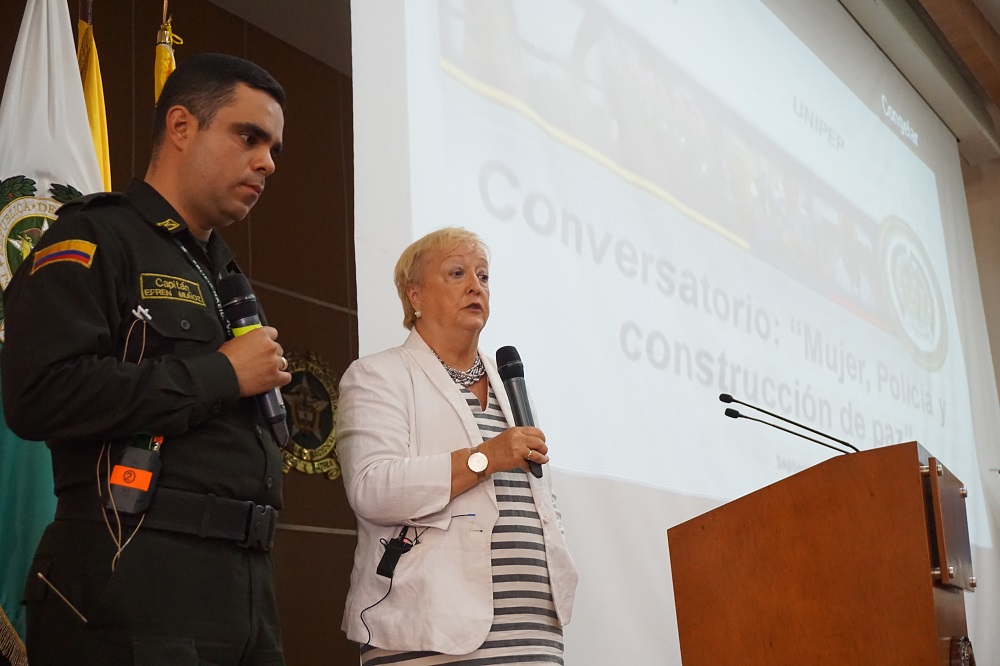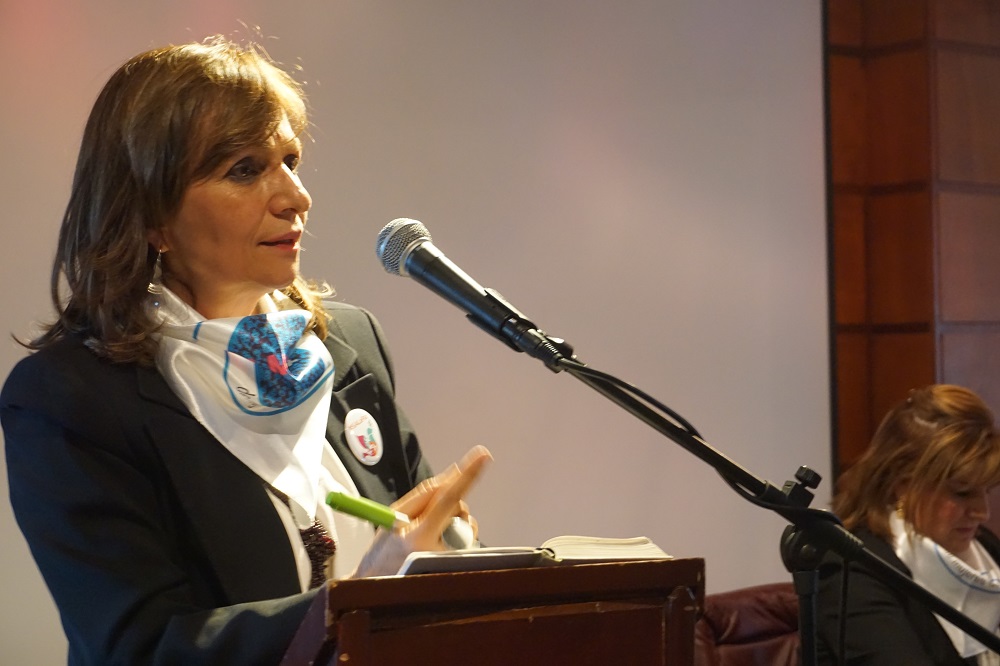A first step to build lasting and sustainable peace in Colombia
On Monday September 26 in Cartagena, Colombia, the Final Agreement ending the conflict between the Colombian government and the Revolutionary Armed Forces of Colombia (FARC-EP) was signed. Real peace, however, involves much more than signing an agreement. This is only a first step. An indispensable one, because it generates spaces for coexistence and restores the bonds of trust that violence has broken. As Colombian Human Rights defender, Claudia Mejia Duque explains: "the war in Colombia not only claimed lives, it also destroyed the trust between us and we must work to rebuild it."

Claudia Mejía Duque, Colombian Human Rights Defender, at event: Women Choose Peace in Bogotá, Colombia. Photo credit: Arnoldo Gálvez.
The armed conflict in Colombia is one of the oldest in the world. According to the report of the National Centre for Historical Memory, between 1958 and 2012 there were at least 220,000 people killed, 25,000 missing and 4,744,046 were displaced. "In Colombia we live a true exodus" says Irma Perilla, director of Thought and Social Action, PAS. "Seeing the dimension of what internal displacement is, motivated me to work for this cause: a negotiated solution to the internal armed conflict."
In order to end the conflict with the FARC-EP, the spirit of the agreement negotiated in Havana between 2014 and 2016, sought to guarantee that the violence would stop and never occur again. To achieve this, the agreement should not be limited to the termination of hostilities, it should also be taken as an opportunity to address the structural problems affecting large groups of the population, particularly in rural areas, which have prompted the emergence of different types of conflicts ranging from ideological and political issues, to organized crime. Therefore, the agreement consists of six points, and compliance with each of them is a necessary condition for a lasting and sustainable peace: comprehensive rural reform, political participation, ending the conflict, solution to the problem of illicit drugs, victims of the armed conflict and the implementation, verification and countersignature of the agreement.
52 years of armed conflict come to an end and new challenges and opportunities emerge
After signing the agreement, the main challenge to building peace in Colombia begins: its implementation. "I am very impressed by the negotiations of Havana. The support they had, the content, the fact that they had a gender commission. They are comprehensive, complete agreements, "says Monica McWilliams, Vice-Chair of Interpeace’s Governing Council and signatory to the peace accords in her native Northern Ireland. "The key question is whether there will be proper resources, sufficient commitment and enough political will to implement these agreements." Resources and political will, are the two pillars on which the long process of building peace in Colombia will stand on, which begins the day after the referendum is held on October 2nd.

Monica McWilliams at event organized by Interpeace Latin America, Alianza Para la Paz and the Colombian Police in Bogotá, Colombia. Photo Credit: Arnoldo Gálvez.
A legitimate peace can never be a decision made at the highest political level, but a possibility subject to democratic decision-making mechanisms. What has been signed between the government and the FARC-EP on Monday, must now be endorsed by the Colombian society on October 2, through a plebiscite where all Colombians answer: "Do you support the final agreement to end the conflict and build a stable and lasting peace? " The main concern of those who support the peace process, is that the ignorance of the content of the agreements, decades of mistrust and the pain of the victims, may prevent an affirmative response.
Peace will not be perfect, and if Colombians decide to endorse the agreement, the peace process will be long and complex. However, there can be no possible solution without ending the armed confrontation. The ceasefire itself, which is just a first glimmer of hope for Colombia, has already brought positive benefits. Irma Perilla assures it: "Today, when we have not yet earned the countersignature, this peace process has already given results: no more soldiers have fallen, no more guerrillas have fallen, no more civilians have fallen caught in the middle of the armed conflict.” Monica McWilliams co-founded the Northern Ireland Monica witnessed the profound changes that peace brought in her country, "the daily life of Colombians will dramatically change once you start implementing the peace agreements. The world will see Colombia under a different light, tourists will begin to arrive in the country, investments will increase as investors seek stability. But most important is the life in the communities, the tranquility that will exist in communities. The primary objective of the agreements must be the security and serenity of Colombians."
Rewriting History in Colombia
One of the most difficult aspects to cope with and assimilate during a peace process is the ability of people to talk to their enemies. However, reconciliation is another essential condition to interrupt the cycles of violence. “If Chile and Argentina had to talk about transitional justice to move from military dictatorship to democracy, in Colombia we have to go through the same thing. Only truth, justice and reparation is what will prevent this from happening again. And for those who think that peace will bring impunity, I'm sure that Colombians will not allow crimes against humanity to go unpunished. " Congresswoman Angela Maria Robledo, Co President of the Peace Commission of the Congress of Colombia, added: "We need to start weaving a common story, seated in truth and memory, so that in the midst of our plurality, we can live together".

Congresswoman Angela Maria Robledo, Co President of the Peace Commission of the Congress of Colombia. Photo Credit: Arnoldo Galvez.
The key to peace, said President Juan Manuel Santos when he began to position the peace process, is not in the bottom of the sea, I have it in my pocket. And we went, women, indigenous people, peasants, Afro-descendants, youth, to say, Mr. President, the key to peace is also ours. "
"Many people thought that the end of the conflict between the Colombian government and the FARC was not possible. And now we see that it is possible, "says Monica McWilliams. "Colombia cannot afford to miss this opportunity. It cannot be enslaved by history; they must make history begin on October . "


